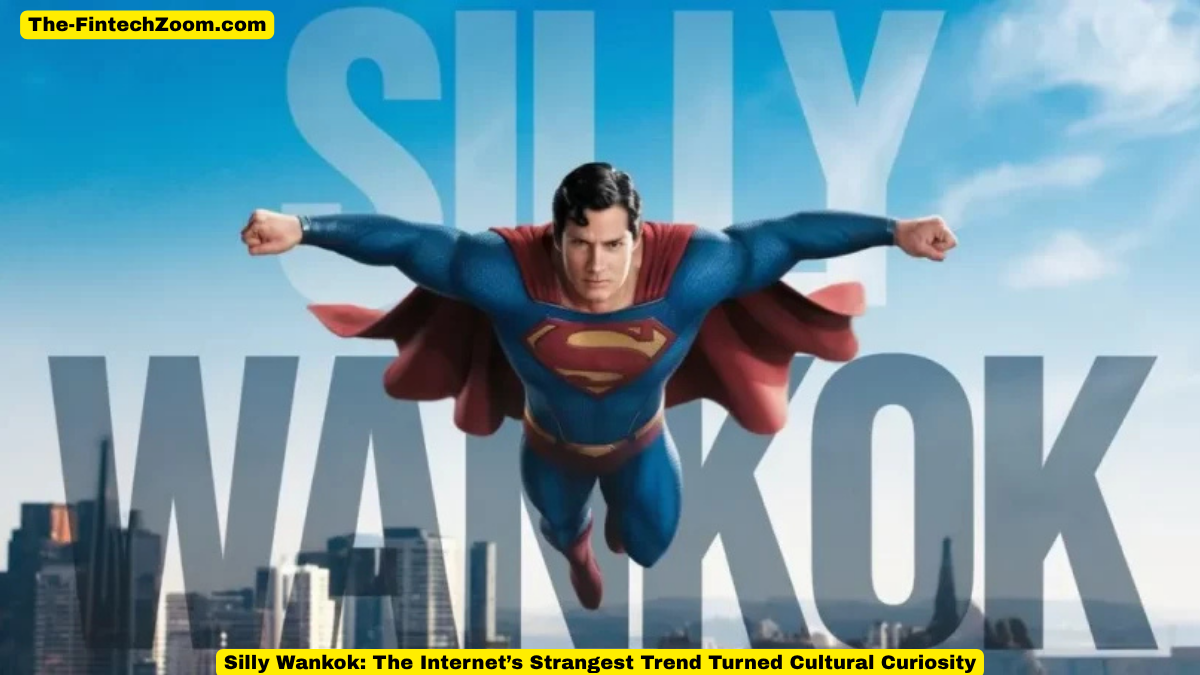Introduction: What on Earth is Silly Wankok?
At first glance, the phrase “Silly Wankok” might seem like a joke, a meme, or a meaningless buzzword that surfaced from the far ends of the internet. But the truth is far more intriguing. “Silly Wankok” is a cultural phenomenon that blends absurd humor, digital rebellion, and creative expression in one hilariously unpredictable package. No, it’s not a brand, a person, or even a place—but it’s become a presence online that can’t be ignored.
While the name sounds like something straight out of a comedy sketch, Silly Wankok has evolved into something that resonates with online communities who thrive on irony, satire, and subversion of the norm. It’s a movement for people tired of curated perfection, and it celebrates being delightfully absurd.
So, whether you’re someone who stumbled upon the term in a meme group, a forum rabbit hole, or a TikTok comment thread, this article will give you the full lowdown on what Silly Wankok means, why it matters, and why it might be the silliest serious thing on the internet right now.
The Origin of Silly Wankok: A Joke That Took a Life of Its Own
The name “Silly Wankok” appears to have been born out of digital randomness—part accidental misspelling, part intentional provocation. Like many internet-born phrases, its exact origin is hard to trace. Some say it came from a Reddit thread where users tried to outdo each other with ridiculous fake city names. Others claim it was first used in a meme mocking serious political discourse with nonsense slang.

Regardless of its roots, one thing is clear: “Silly Wankok” was never meant to be taken seriously. Its charm lies in its sheer absurdity. It doesn’t refer to a location, a person, or even an idea in the traditional sense. Rather, it serves as a placeholder for everything weird, whimsical, and wonderfully unnecessary in digital culture.
But the internet has a history of making big deals out of little things. Much like “Shrek is love, Shrek is life” or the resurgence of “Skibidi Toilet,” Silly Wankok took on a life of its own. Memers began creating lore around it. Artists illustrated imaginary maps of “Wankok.” Influencers joked about “Silly Wankok vibes” in reels. In a matter of weeks, the term spread like wildfire across Discord servers, meme pages, and reaction videos.
Silly Wankok as a Meme Aesthetic
If we had to categorize Silly Wankok under a broader trend, it would sit somewhere between post-irony meme culture and absurdist humor. This aesthetic thrives on content that breaks traditional comedic structures—think anti-jokes, lo-fi animations, or overly edited TikToks that make no logical sense but feel oddly satisfying.
Silly Wankok became a symbol for this type of content. The name alone evokes confusion, followed by amusement. Meme creators love it because it’s completely open-ended. It doesn’t come with baggage. There are no rules. “Silly Wankok energy” could mean anything from dancing in a banana costume in public to using Google Translate to butcher a love letter in 20 languages before sending it.
This kind of humor, deeply rooted in Gen Z and younger millennials, offers relief from the overly polished Instagram aesthetic and influencer lifestyle. People crave something real, even if it’s ridiculous. Silly Wankok delivers that in full.
The Community Behind the Nonsense
Despite being “silly,” Silly Wankok has brought together a community of like-minded digital pranksters, meme lords, ironic commentators, and cultural observers. It’s more than just a joke—it’s a commentary on how quickly culture mutates online. These communities gather on Reddit subs, Discord channels, Instagram meme hubs, and even forums on Tumblr and 4chan to share their latest “Wankokian” content.
The unspoken rule? The more bizarre, the better.
One common practice is creating fake lore. Users pretend that Silly Wankok is a lost civilization, a parallel universe, or a chaotic neutral kingdom where anything goes. They build fake histories, politics, and social structures for it. This creative chaos fosters collaboration. Artists draw posters, animators bring scenes to life, and coders build mini games themed around “Silly Wankok Adventures.”
This mirrors older online subcultures like the SCP Foundation or the backrooms, where collective imagination turns nonsense into a fully-fledged mythos.
Silly Wankok on Social Media: The Rise of “Reel Handwriting”
As Silly Wankok started to trend on platforms like TikTok and Instagram Reels, creators found ways to link the term with other viral formats. One such trend is “reel handwriting.”
In these videos, people pretend to write deep thoughts, dramatic quotes, or emotional revelations—only to suddenly derail into utter Wankokian chaos. For example, a video might start with “Sometimes you have to lose everything to find…” and then descend into “Silly Wankok National Anthem playing over potato footage.”
These reels parody “aesthetic” self-help videos or motivational quotes, reminding viewers not to take everything so seriously. Reel handwriting in this case becomes a comedic device—a setup for chaos rather than clarity.
Even handwriting itself is becoming a meme. Some creators intentionally scribble like children or use mismatched fonts to visually embody the absurdist spirit. “This is my Silly Wankok handwriting,” one caption read, over a clip of someone writing with a toothbrush dipped in ketchup.
Silly Wankok and the Anti-Algorithm Movement
There’s something rebellious about how Silly Wankok operates—it doesn’t chase clout, optimization, or monetization. It often exists in spaces actively hostile to influencer culture and algorithm-driven content. It doesn’t follow trends; it laughs at them.
The more unpredictable a post is, the more “Silly Wankok” it’s considered. It’s a resistance to the over-curation of the digital world. It’s digital punk rock, painted in memes and jokes instead of guitar riffs and mohawks.
Some believe Silly Wankok is part of a larger anti-algorithm movement. These are creators who intentionally subvert what platforms like YouTube or TikTok promote. They post incoherent edits, use jumbled hashtags, or layer sounds in ways that would make an AI cry. The point is to break out of the content mold. To make anything, especially if it makes no sense.
Silly Wankok fits perfectly here. It’s not polished. It’s not marketable. And yet, it spreads.
The Art of Handwriting in the Wankok Era
Now let’s circle back to an unexpected hero in the Silly Wankok story: handwriting. Surprisingly, handwriting has made a comeback, not in the elegant calligraphy way, but in chaotic, Wankok-inspired doodles. Pages filled with illegible nonsense, half-thoughts, and phrases like “Banana Parliament Wankok Supreme” scrawled in different pen colors—it’s become a style.
Young artists and students create “handwritten memes” on actual paper, scan them, and upload them with the tag #WankokScript. It’s low-effort, low-fi, but strangely captivating.
In an overly digital world, messy handwriting feels real. Honest. Human. When paired with Silly Wankok themes, it becomes even funnier. Imagine someone writing an entire fake court case in cursive about “Silly Wankok being sued by the Spaghetti King.” That’s real. That’s happening.
From Nonsense to Expression: The Philosophy of Wankok
It may sound ridiculous, but there is something philosophical at the heart of Silly Wankok. It’s the idea that you don’t need a reason to create. You can be expressive without being impressive. You can be silly without being stupid. You can participate in culture without contributing anything of value—and that’s okay.
Wankokian humor is a reaction to pressure. Pressure to perform. To be productive. To be aesthetic. To be impressive online. Instead, this trend says: “Just post. Just create. Just be weird.” That freedom is what makes it so contagious.
In a way, Silly Wankok represents an emotional release. Like Dadaism in the 1920s, which also mocked logic and formality in art, this meme movement mocks internet perfectionism.
Why Silly Wankok is More Important Than You Think
Sure, it’s absurd. But that absurdity is its power. Silly Wankok connects people through laughter, confusion, and shared nonsense. And in an age of disconnection, that’s not so silly after all.
Where most viral trends burn out quickly, Silly Wankok adapts because it has no fixed definition. It is what people make of it. And that might just be the secret to its longevity.
FAQs About Silly Wankok
1. Is Silly Wankok a real place?
Nope! Silly Wankok is entirely fictional. It’s a made-up term used humorously online. Some fans do make fake maps and stories about it, but it’s all for laughs.
2. Who started the Silly Wankok trend?
There’s no clear creator. Like most meme movements, it organically emerged across multiple platforms like Reddit, TikTok, and Instagram. Its appeal lies in the mystery.
3. Why do people write “reel handwriting” about Silly Wankok?
It’s part of the joke. The reels mimic serious motivational videos but then twist into bizarre Wankok content. Handwriting is often used to enhance the parody effect.
4. What does “Wankok energy” mean?
It’s a phrase used to describe something that’s weird, unexpected, chaotic, or absurd in a humorous way. Like a vibe check, but with total nonsense.
5. Is there any deeper meaning to Silly Wankok?
Yes and no. On the surface, it’s pure absurdity. But beneath that, it represents a cultural pushback against perfectionism, productivity culture, and internet uniformity.
Final Thoughts: Handwriting, Reels, and the Eternal Wankok
Silly Wankok isn’t going anywhere. It’s carved out a niche in the internet’s chaotic landscape. From hand-drawn doodles to reels that explode into absurdity, the trend thrives because it refuses to conform. It’s raw creativity with no strings attached.
So, next time you see a post that makes absolutely no sense—but still makes you laugh—don’t scroll past it. You just might be witnessing a little piece of Silly Wankok magic.
And if you ever feel stuck, uninspired, or under pressure to be “content-worthy,” just pick up a pen, scribble something completely absurd, and remember: in the kingdom of Silly Wankok, everyone is king.

